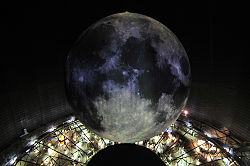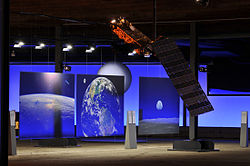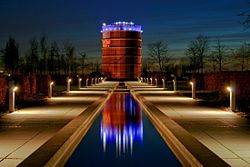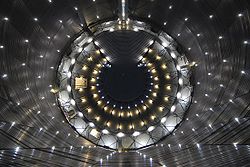- Gasometer Oberhausen
-

Oberhausen GasometerGeneral information Location Oberhausen, Germany Height 117.5 m (385 ft) Technical details Diameter 67.6 m (222 ft) Floor area 7,000 m2 (75,000 sq ft) Website http://www.gasometer.de The Oberhausen gasometer, the largest disc-type gas holder in Europe, is an industrial monument located in Oberhausen, Germany. It was constructed between 1927 and 1929. Today it is an Anchor Point of the European Route of Industrial Heritage and serves as an exhibition hall. The present exhibition 'Out Of This World - Wonders Of The Solar System' was named an official project of RUHR.2010, the European Capital of Culture 2010.
Contents
History
During the 1920s, industry had a firm hold on the area covered today by the city of Oberhausen: - pit heads, coking plants and iron works were typical sights there as in other parts of the Ruhr valley.
However, the plants were not networked efficiently. Typically, top gas produced in the iron works was used to fire several coking ovens. However, during periods of low iron production, coal or oil had to be burned for coke production. Similarly, when coke production was slow, the iron works had to flare off their unused gas. The Gasometer was intended to remedy the losses by storing gas and releasing it as required.
In February 1927, its construction was commenced. After roughly two years, the largest gas holder in Europe stood with a height of 117.5 m[1] and a diameter of 67.6 m. It had an effective volume of 347,000 cubic metres and cost 1.74 million Reichsmarks.
During World War II, the Oberhausen gas holder was hit by bombs several times, eventually being shut down in January 1945, just before the end of the war. A year after the war, it caught fire during repair work and had to be demolished down to its foundations, although several elements, such as its roof, were re-used during its reconstruction, which lasted until 1949.
After the demand for coke stagnated, the coking plant in Oberhausen was closed, and its gas was increasingly replaced by natural gas supplied via pipelines. The Gasometer became superfluous and it was decommissioned in 1988.
The Oberhausen Gasometer today
After its decommission, the Gasometer could have been demolished like many industrial relics. Instead, the citizens of Oberhausen, the city council, the regional government of North Rhine-Westphalia and the Emscher Park International Building Exhibition intensely discussed whether and how an obsolete gas holder could be used again. The city council proposed to convert the Gasometer into an exhibition hall[1] which remains a landmark of the city of Oberhausen. Conversion and restoration cost amounted to approximately DM 16 million, most of it provided through the promotional funds of North-Rhine Westphalia.
Conversion was completed in 1993–94 by Deutsche Babcock AG. The former gas-pressure disc was fixed at a height of 4.50 metres. Today the space below it is a circular 3000 square meter room for the visitors. Two steel staircases lead up onto the disc in the middle of which raises a stage with a diameter of 20 meters. Parts of the supporting structure became a stand with 500 seats.
During the International Building Exhibition in 1999, the artist Christo and Jean-Claude created the Wall, consisting of 13,000 coloured oil drums which were piled up in rows up to 26 metres.[2] The Wall divided the Gasometer into two sections of equal size, thus symbolizing the transformation of the Ruhr valley along economic, cultural, ecologic and social lines.
The Oberhausen Gasometer in the Year of Astronomy 2009
Between April 2009 and December 2010[3] the Gasometer hosts an exhibition called Out of this World - Wonders of the Solar System marking the International Year of Astronomy. The exhibition describes the solar system as a process of growth and decay. Reproductions of the planetary system, images of the sun, of the planets and their moons, historical instruments and modern technology of space research graphically presents the drama of the birth and development of the solar system up to its possible end. The show is centered around the 25-meter sculpture of 'the largest moon on earth'[3].
Past Exhibitions
Fire & Flame
'Fire and Flame' for the Ruhr. The first exhibition in Oberhausen's Gasometer in 1994 documented 200 years of the history of a region which could hardly be more exciting. Where was it possible to better impart knowledge of industrial history than in one of its most striking monuments? No other region in Europe was so characterised by heavy industry than the Ruhr. 'Fire and Flame' impressively showed with historical photos, machines and everyday items to what extent the years of its infancy, the boom and the decline of the iron and coal industry have been reflected in the culture of the Ruhr's population.
I Phoenix
'I Phoenix' was the art event in the Oberhausen Gasometer in 1996. Renewal, the change of the times - in themselves, considered optimistically and with self-confidence, but also pensively. And that at a place which itself is a clear symbol of change. The gigantic gasometer was designed as a pragmatic space and efficient machine by engineers - now it was not only to be an atypical exhibition hall for contemporary art, but at the same time a provider of ideas for quite new, quite different concepts of change. 'I Phoenix' dealt with the sterile world of work, with the decline of the industrial era and its traces, but also with the future. What came out of that was an unprecedented modern art event in the most unusual exhibition hall in Europe. More than 96,000 visitors saw 'I Phoenix' in only five months; many of them did not rank among the typical exhibition public. The venue and the spectacular staging of the works of art aroused the curiosity of people who were otherwise not particularly interested in art. That too was a change.
The Dream of Vision
"The exhibition is more exciting and entertaining than the Saturday evening programmes of all of the TV stations together". The Frankfurter Allgemeine Zeitung could hardly have paid the exhibition 'The Dream of Vision' a finer compliment in 1997. But not only the critics were enthusiastic, the viewing figures were also right - in total more than 540,000 visitors came to the Gasometer to 'watch TV', gained their own picture of television and turned the Gasometer into a gigantic 'goggle box'. The most used medium by far was ready for its first great cultural history exhibition.
The Wall
'The Wall' consisted of 13,000 oil drums stacked on top of one another in seven colours which together weighed 234 tons. It was 26 metres high, 68 metres wide and seven metres deep. The installation by the world famous artist couple Christo and Jeanne-Claude fascinated about 390,000 visitors within only six months in 1999. A superlative work of art, realised by the Christo photographer Wolfgang Volz. These were quite new perspectives in the Oberhausen Gasometer.
The Ball is Round - The football exhibition
'The Ball is Round'*, the exhibition for the centenary of the German Football Federation, was a smash hit. About 216,000 visitors came on the 174 days of the exhibition. There was a stadium atmosphere in the gigantic ‘industrial cathedral’. That football is more than just a sport was already something people had always assumed. In the Gasometer you could also see it. More than 2500 exhibits, pictures, devotional objects, films showed football culture in the best form. From the beginnings of modern football in England around 1850 up to the worldwide media event. 'The Ball is Round' documented the unique development of this sport. The focus of the exhibition was on football in Germany, linked with the hundred years of the German Football Federation’s history.
Blue Gold
Water is a valuable and scarce resource, more valuable than oil. 'Blue Gold' was accordingly the title of a production setting the scene for the subject of water in Oberhausen's Gasometer. The way in which the scene was set for the element was absolutely not dry, but spectacular and sensuous. First of all, the visitors to 'Blue Gold' virtually went through the desert. A total of 833 tons of ultra-fine, bone-dry sand covered the floor of the Gasometer several centimetres deep. On the next level, you fancied you were on the right way to the 'Blue Gold'. In the sound and video installation by Paul Schütze the water flowed upwards on 22 projection surfaces, showed the direction towards the spectacular climax of the exhibition, a 50 metre high, strikingly illuminated cone of water. This huge cone stood in the middle of a 400 square metre-large lake, 7500 litres of water were permanently in circulation here and flowed down the outer skin of the object. Together with a spectacular sound and light installation the water became something that you could experience sensuously - without getting wet in the process.
'Five Angels for the Millennium'
In May 2003, five beings moved into the Gasometer which were seemingly not of this world: - 'Five Angels for the Millennium' - an installation by Bill Viola, one of the most important video artists worldwide. The five angels for the new millennium entered into a spherical dialogue with the huge industrial cathedral. Never before had Viola shown his installation completed in California in 2001 in a comparable room.
'Five Angels for the Millennium' consists of five complementary video sequences: - the Ascending Angel, the Birth Angel, the Creation Angel, the Departing Angel and the Fire Angel. On huge screens on the steel walls of the Gasometer, suspended at heights between twelve and 64 metres the images shimmered, shone, sprayed and exploded. In addition there were sounds which with the special acoustics of the Gasometer gave you an inkling of infinity.
Wind of Hope
Bertrand Piccard himself had not yet seen his Breitling Orbiter 3 like this: - in its full size the gigantic, silvery glittering balloon first hung in a building in 2004. It was 55 metres high, with a diameter of 32 metres, and spotlighted to great effect. It was with a balloon like this that Piccard from Switzerland and his British co-pilot Brian Jones succeeded in doing in 1999 what nobody before had ever achieved - they travelled non-stop once round the earth. In 19 days they covered 40,813 kilometres. 'The Wind of Hope' in Oberhausen's Gasometer told the adventurous story of the circumnavigation of the earth in the balloon.
Fire Light Sky
A look back and fantastic new views upwards – that was Fire Light Sky. There was 'the fire' in 2006 in the lower area of the gasometer. An exhibition here showed the development from the industrial building to the most unusual exhibition hall in Europe. Large-format photographs and exhibits told the exciting story of the Gasometer – from the era when it was the largest gas holder of its kind in Europe to the spectacular space for art, starting with the first exhibition in the Gasometer in 1994: 'Fire and Flame'.
Light Sky is today the cosmic pantheon of the Gasometer. Two light circles and 24 light lines, natural and instrumental sounds invite you on a sensuous journey through the gigantic, more than 100 metre-high room. The light lines follow a strictly geometrical course vertically along the walls and as a result of the room's dimensions they produce the impression that they taper upwards. It seems as if Light Sky has provided the industrial cathedral with its dome.
References
External links
- http://en.erih.net/ European Route of Industrial Heritage
- http://www.route-industriekultur.de/primaer/a18/a18.htm
- Gasometer Oberhausen View in 3D
Categories:- Ruhr Industrial Heritage Trail
- European Route of Industrial Heritage Anchor Points
- Oberhausen
- Buildings and structures completed in 1929
- Buildings and structures in North Rhine-Westphalia
- Museums in North Rhine-Westphalia
- Art museums and galleries in Germany
Wikimedia Foundation. 2010.




